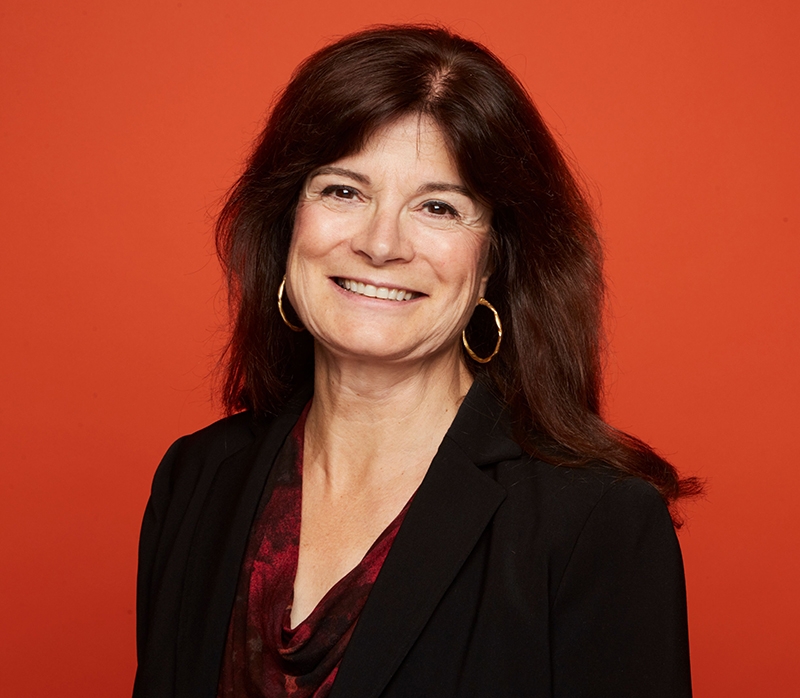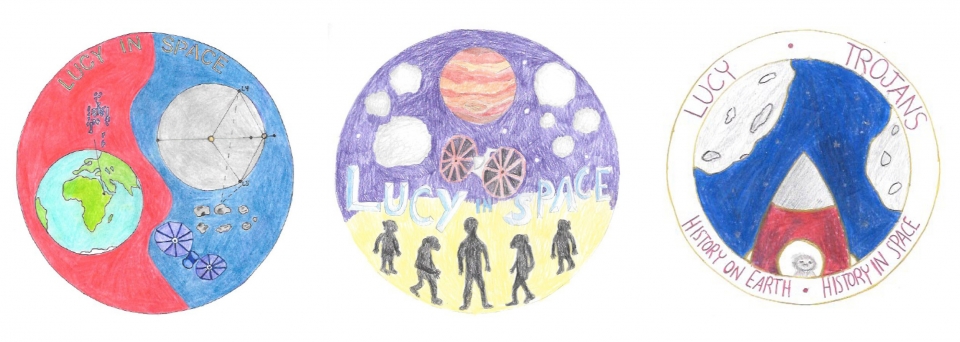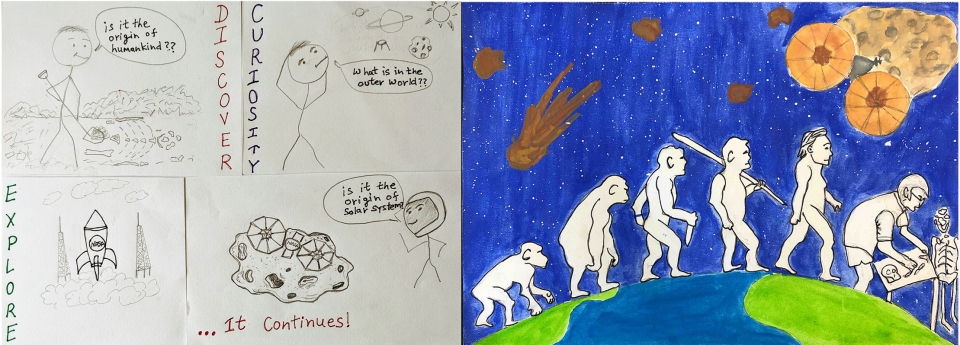Feeding the hunger for meaning | ASU News - ASU Now - Arizona State University
Feeding the hunger for meaning | ASU News - ASU Now - Arizona State University |
| Feeding the hunger for meaning | ASU News - ASU Now - Arizona State University Posted: 27 May 2021 03:41 PM PDT May 27, 2021 ASU English Professor Sally Ball contributes to global art projectIt's no coincidence that the exhibit map for "Telephone," an ambitious project that enlists creators of all kinds to mimic the classic children's game by "whispering" a message from one art form to another, resembles the branches of a tree. Nathan Langston, who conceived of the project, now in its second iteration, was inspired by that metaphor when considering what message to begin the game with. The 2015 iteration of "Telephone" had used "The Breton Fisherman's Prayer" as its original message. This time around, Langston settled on a passage from the book "Ladders to Heaven: The Secret History of Fig Trees," by British biologist Mike Shanahan, about the banyan tree, a type of fig tree capable of growing so large as to resemble a forest from afar. Arizona State University English Professor Sally Ball, who contributed to the project, was surprised to learn from whence it came – each artist participating in the game is only aware of the artwork that directly preceded their own, so the original piece that prompts the rest is a mystery to all but the first few tasked with interpreting it. From there, the original message could morph from poetry to music to film, and so on, with each interpretive work being "whispered" on to two or three more artists. Halfway through the game, the method is reversed; instead of a few artists receiving one work to interpret, one artist receives a few to synthesize into one, eventually concluding with a single work of art, at which time the original prompt is revealed to all. To Ball, who did not participate in the 2015 iteration, "The Breton Fisherman's Prayer" seemed a decidedly more poetic nugget of language to employ as a prompt for such a project than Shanahan's austere historical account of the first Europeans to have seen a banyan tree. "It seemed almost like it was designed to provoke drastic interpretive leaps," Ball said. The game itself, according to Langston, was resurrected in March 2020, at the onset of the pandemic, in part because of its ability to make drastic leaps in space, "connecting strangers in a uniquely intimate way" at a time when physical closeness wasn't possible.  ASU Professor of English Sally Ball If you ask Ball, it was successful in that endeavor. "It very much felt like a kind of rescue from isolation," she said. The second iteration is now complete and available to view as a free, interactive digital exhibit on the project website. It includes the work of more than 950 artists from 474 cities in 69 countries. Ball's contribution, a poem titled "Red Life," was inspired by the preceding artwork (referred to, as all preceding artworks in the project are, as "last generation" in the hyperlink that will take you to it in the exhibit), a short film by the German artist Beatriz Crespo. In "Red Life," Ball contemplates form, along with what can be contained in a work of art and what might spill out. When you watch the film that she drew from, with its words that run off the page onto a table and crazed glass bowls filled with bits and bobs, a throughline begins to emerge. The practice of ekphrasis — drawing from a work of visual art to create vivid, verbal descriptions — is one Ball had been exploring on her own for some time. "SO MUCH OF THE WORLD STAYS BEAUTIFUL: HOLD," is a product of that exploration. A limited-edition artist's book, "HOLD" represents Ball's collaboration with Czech gravuristGravure printing is a style of printmaking or relief printing where an image is incised into the surface of a copper plate. Jan Vicar. In it, words from her poem of the same name — which appears in her third, full-length collection, "Hold Sway," an examination of climate change — appear next to linocut prints of oil rigs and various flora and fauna. Ball recently visited Paris to read from the book and discuss the process of making it at an exhibit of Vicar's after he received an award for his work from the French Academy of Fine Arts (Academie des Beaux-Arts). This fall, the book will be on exhibit at the Harry Wood Gallery at ASU. "My grandmother was a painter, and I think in my life, she's the person who made art seem sort of real and doable to me, and not locked up in a museum or outside of the lives of everyday people," Ball said. "I did not turn out to be a painter, but I think that having come to a sense of art from that orientation, I've always felt a kinship with other kinds of artists." During Ball's sabbatical in 2015, she spent a month at an artist's retreat, where she assumed she'd be accompanied by at least a few other writers. As it turned out, she was the only one; everyone else was a visual artist. "I loved being in their company and I felt so buoyed and like I was learning from them and the way that they approach their work," she said. "My first book, 'Annus Mirabilis,' is about the way scientists seek knowledge and the ambition that scientists have as compared to the ambition that artists have to understand things and to know things and to interpret meaning out of the universe. I guess I'm just sort of a meaning-hungry person." Top photo courtesy of Pixabay  May 27, 2021 Just months before the launch of NASA's Lucy mission, winners of the Lucy in Space contest have been announced by Arizona State University's Institute of Human Origins. First place winners will receive invitations to attend the spacecraft launch from Cape Canaveral Space Force Station in Florida. Middle and high school students who had the winning entries in the "Lucy in Space" contest — promoted through ASU's AskAnAnthropologist website — were notified the week of May 10 of their first, second or third place wins, or honorable mentions. Sculpture, drawings, poetry and even haiku were produced as creative works of art and writings for entries to make a connection between our human drive for discovery and exploration of our origins on Earth and in our own solar system. In fall 2020, the Institute of Human Origins launched this contest for U.S. middle and high school students to engage students' imaginations in the upcoming NASA Lucy mission, led by the Southwest Research Institute. The contest was supported by NASA as part of its efforts to engage students in this solar system STEM enterprise of exploration to inspire interest in science, technology, engineering and mathematics. The Southwest Research Institute, ASU School of Earth and Space Exploration, and L'SPACE — a Lucy mission-sponsored, ASU-led NASA workforce development program — also supported and promoted the contest as STEM education outreach. The contest winnersMiddle school students created a mission "patch" design, and high school students were encouraged to create any type of art or video as a message to the "future finders" of the Lucy mission spacecraft. Both groups were asked to write an essay or poem to describe their art. The first-place entry for the middle school level went to eighth grader Tim Topping of St. Mary Catholic School in Littleton, Colorado, whose parents are both ASU graduates. Second- and third-place winners — Jane Hanselman and Annemarie Stanga, respectively — were also from St. Mary Catholic School — a sweep of the top middle school entries. Winning middle school mission patch designs (left to right) Tim Topping, Jane Hanselman, Annemarie Stanga. All three students are eighth grade students at St. Mary Catholic School in Littleton, Colorado. Sarah Tran, the first-place winner of the high school level, created a video and a poem for her entry. And although contest entries were received from all over the United States, this first place entry came from a junior attending Hamilton High School in Chandler, Arizona. The second-place winner is Aarav Gupta, a ninth grade student from Bellamine College Prep in San Jose, California, and the third place winner is Tsehai Alfred, a 10th grade student attending Good Hope Country Day School on St. Croix in the U.S. Virgin Islands. High school first-place winner Sarah Tran, 11th grade, Hamilton High School, Chandler, Arizona. First-place winners will receive virtual visits to their school by Institute of Human Origins Founding Director Donald Johanson, NASA Lucy mission Principal Investigator Hal Levison and Deputy Principal Investigator Cathy Olkin, and an invitation to attend — along with their teacher — the launch of the mission at Cape Canaveral in Florida in October 2021. (The winners/teachers will be responsible for costs to attend.) The first-, second- and third-place entries in each category will be featured on a NASA website with the top 10 entries in each category featured on the AskAnAnthropologist.asu.edu website. The initial contest "blind" judging was done by four IHO-affiliated graduate students and four graduate students who are "Lucy Ambassadors" and work on education outreach with L'SPACE, made up of students from across the country who have been trained to teach the public about the Lucy mission.
High school second-place winning entry (left) Aarav Gupta, ninth grade student, Bellamine College Prep in San Jose, California, and third-place high school entry (right) Tsehai Alfred, 10th grade student, Good Hope Country Day School, U.S. Virgin Islands.  Carolyn Porco volunteered her time as final judge for the contest. Image courtesy Carolyn Porco. The final judging for the top three winners was done by Carolyn Porco, a planetary scientist who was the leader of the imaging science team on the Saturn Cassini mission from 2004 to 2017 and a veteran imaging scientist on the Voyager mission to the outer solar system in the 1980s. The unique connection between human origins and astronomy was initiated by the Southwest Research Institute team led by Principal Investigator Hal Levison and Deputy Principal Investigator Cathy Olkin, who are heading NASA's Lucy mission to explore the Trojan asteroids. The Lucy mission will make history as the first space mission to study the Trojan asteroids, a population of small bodies orbiting the Sun "leading" and "trailing" Jupiter, at the same distance from the Sun as the gas giant. The mission will explore seven of these asteroids that hold vital clues to deciphering the history of the solar system, including a flyby of 52246Donaldjohanson asteroid. Since these rocky remnants promise to help us understand the origins of our solar system, the team named the mission for "Lucy," the 3.2 million-year-old fossil skeleton discovered by Johanson in Ethiopia in 1974. Lucy's species, Australopithecus afarensis, is believed to be an ancient ancestor of our own genus Homo. The Institute of Human Origins is one of the preeminent research organizations in the world devoted to the science of human origins. The Lucy mission spacecraft is scheduled with a launch window open from Oct. 16 to Nov. 5, and will be carrying an ASU-built instrument — a thermal emission spectrometer, which is being developed by a team led by ASU's Philip Christensen. To view the top 10 entries in each level, visit AskAnAnthropologist.asu.edu/Lucy-in-Space.  |
| Posted: 30 May 2021 11:33 AM PDT  Netanyahu claims Bennett instigating 'the fraud of the century,' but can yet be thwartedSpeaking just a few minutes after Yamina leader Naftali Bennett, Prime Minister Netanyahu accuses his right-wing rival of misleading the Israeli public in claiming that Netanyahu has no options to form a coalition. He claims Bennett is instigating "the fraud of the century," cheating voters and lying about the political reality, and says that the Yamina chief only cares about being prime minister, but can still be thwarted. Netanyahu again floats his proposal for a government in which New Hope chief Gideon Sa'ar will serve as prime minister first, followed by himself and then Bennett. Sa'ar rejected such a government earlier today. He also asserts that MKs have told him they will break with their parties to join with his right-wing religious bloc once Yesh Atid leader Yair Lapid's mandate to form a government ends, on Wednesday. Netanyahu begins by saying that two million Israelis voted for him — either directly for Likud or for parties that back him as prime minister — "because of my loyalty to the Land of Israel, the State of Israel, the security of Israel and the future of Israel. "They know my compass won't malfunction," he says in a first dig at Bennett. Bennett is trying to fool the public, accusing others of spreading hatred and division, when he is the one spreading hatred and division, says Netanyahu. He accuses Bennett of perpetrating "the fraud of the century," recalling that Bennett signed a pledge just before the March 23 elections that he would not allow Yair Lapid to become prime minister, not even via rotation. "There is not a person in the land who would have voted for you had they known," what Bennett had in mind, says Netanyahu. He says that Bennett "flipped" immediately after the elections and began working to become "prime minister at any price," and then flipped again during this month's fight against Hamas — when he said "the left-wing government is off the table." Now, says Netanyahu, Bennett has done a third flip — in favor of a left-wing government. "What has changed? Nothing" — It's just that "he's trying to fool voters and drag votes to the left." Netanyahu says the battle is not yet lost. Instead of "a dangerous left-wing government," a "good right-wing government" can yet be built after Lapid's mandate ends on Wednesday. This could be via the arrangement he proposed earlier today — whereby Gideon Sa'ar, Netanyahu and Bennett would take turns in that order as prime minister. That would be "very unacceptable, unusual, and skewed," he says, but still better than a left-wing government. Alternatively, he says, there are enough MKs "who can give us more than 61 votes" in the 21 days after Lapid's mandate ends — when the 120-seat Knesset would have the opportunity to rally behind a prime minister of its choice. He says these MKs — presumably defectors from Bennett's, Sa'ar's, and other "change bloc" parties — are saying they are "coming to a right-wing government." Bennett does not want a fifth general election "because he knows he'll be wiped off the political map; he won't clear the threshold," says Netanyahu. "He only cares about himself." "I call on the MKs who were elected with right-wing votes: stick with that path — don't establish a left-wing government," urges Netanyahu. "That government is a danger to the security of Israel and a danger to the future of the state." He adds: "If heaven forbid it is established, in a few days, the security cabinet of the State of Israel [will include] Yair Lapid, [Meretz's Nitzan] Horowitz, [Labor's Merav] Michaeli, and [Meretz's] Tamar Zandberg." He scoffs: "What impact will that have on Israel's deterrent capability? How will we look to our enemies? What will they say in Iran and Gaza? What will they do in Iran and Gaza? What will they say in the corridors of the administration in Washington? "Will Lapid, Zandberg, and company face down Iran?" he asks rhetorically. "They wholeheartedly support that dangerous nuclear agreement. They'll fight Hamas? They depend on the votes of [Arab MKs Ahmad] Tibi and [Ayman] Odeh. They'll defend our soldiers in The Hague?… Who'll protect the settlements…? It's a joke…" Citing what he calls "another ridiculous fraud," Netanyahu says: "They call this left-wing government a 'unity government.' It's a government with 40 left and hard-left seats, with a fig leaf of parties that took votes from the right and brought them to the left, reliant on the support of anti-Zionist votes. And that they call a unity government!" Fifty-two mandates of the "real right" are being pushed aside, he says. As for the Bennett-Lapid talk of national healing, Netanyahu asks: "The two million voters" who wanted him "are a sickness that needs healing?" While claiming to be democratic, his rivals "are trying to pass legislation to prevent me winning future elections" in a process he compares to Syria, Iran, and North Korea. "Not unity, not healing, not democracy — it's an opportunistic government, a government of surrender and fraud," he says. "It must not be established." He again urges MKs elected with right-wing votes: "Don't cheat the public who supported you, and don't cheat yourselves… If you're a right-winger, you don't vote for a left-wing government. And if you vote for a left-wing government, you are not a right-winger." He concludes: "Stand up against the left-wing government, and with God's help we'll together establish a right-wing government for the good of all of Israel's citizens." |
| You are subscribed to email updates from "whatcan i make with figs" - Google News. To stop receiving these emails, you may unsubscribe now. | Email delivery powered by Google |
| Google, 1600 Amphitheatre Parkway, Mountain View, CA 94043, United States | |





Comments
Post a Comment